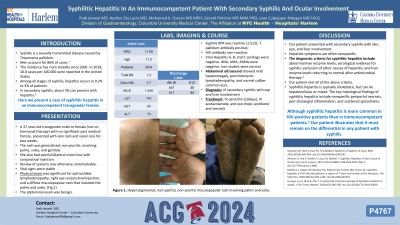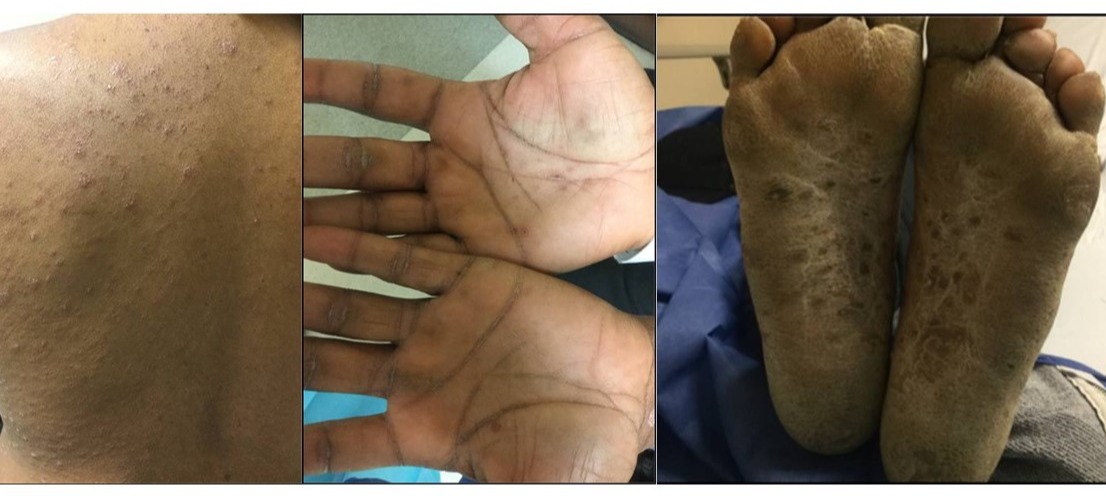Tuesday Poster Session
Category: Liver
P4767 - Syphilitic Hepatitis in an Immunocompetent Patient With Secondary Syphilis and Ocular Involvement
Tuesday, October 29, 2024
10:30 AM - 4:00 PM ET
Location: Exhibit Hall E

Has Audio
- IJ
Ihab Jameel, MD
NYC Health + Hospitals/Harlem
New York, NY
Presenting Author(s)
Ihab Jameel, MD, Aprilee Sta Lucia, MD, Mohamed K.. Osman, MD, MPH, Gerald Fletcher, MD, MBA ,PHD, Joan Culpepper-Morgan, MD, FACG
NYC Health + Hospitals/Harlem, New York, NY
Introduction: Syphilis is a sexually transmitted disease caused by Treponema pallidum. Men account for 86% of cases. The incidence has risen steadily since 2001. In 2018, 10.8 cases per 100,000 were reported in the United States. Among all stages of syphilis, hepatitis occurs in 0.2% to 3% of patients. In secondary syphilis, about 3% can present with hepatitis. Here we present a case of syphilitic hepatitis in an immunocompetent transgender female.
Case Description/Methods: A 37-year-old transgender male to female (not on hormonal therapy) with no significant past medical history, presented with skin rash and vision loss for two weeks. The rash was generalized, non-pruritic, involving palms, soles, and genitals. She also had painful bilateral vision loss with conjunctival injection. Review of systems was unremarkable. Vital signs were stable. Physical exam was significant for epitrochlear lymphadenopathy, right eye conjunctival injection, and a diffuse maculopapular rash that included the palms and soles. The abdominal exam was benign. Laboratory results showed WBC 11.68, hemoglobin 11.2, platelets 507, total bilirubin 1.2, direct bilirubin 0.7, ALP 1,449, AST/ALT 80/70, GGT 747. Syphilis RPR was reactive (1:512); T. pallidum antibody positive; and HIV antibody non-reactive. Viral Hepatitis A, B, and C serology were negative. ANA, AMA, ASMA were negative. Iron studies were normal. Abdominal ultrasound showed mild hepatomegaly, pericholecystic lymphadenopathy, and normal caliber common duct. A diagnosis of secondary syphilis with eye and liver involvement was made and managed with IV penicillin, IV acetazolamide, and eye drops (antibiotic and steroid). The patient received 10 days of IV Penicillin. On discharge, ALP 612, ALT 44, and AST 30.
Discussion: Our patient presented with secondary syphilis with skin, eye, and liver involvement. Hepatitis symptoms are often nonspecific. The diagnostic criteria for syphilitic hepatitis include abnormal liver enzyme levels; serological evidence for syphilis; exclusion of other causes of hepatitis; and liver enzyme levels returning to normal after antimicrobial therapy. Syphilitic hepatitis is typically cholestatic, but can be hepatocellular or mixed. Our patient met all of the above criteria. The key histological findings of syphilitic hepatitis include nonspecific periportal necrosis, peri-cholangial inflammation, and scattered spirochetes. Syphilitic hepatitis is more common in HIV-positive patients than in immunocompetent patients. Our patient was HIV negative.

Disclosures:
Ihab Jameel, MD, Aprilee Sta Lucia, MD, Mohamed K.. Osman, MD, MPH, Gerald Fletcher, MD, MBA ,PHD, Joan Culpepper-Morgan, MD, FACG. P4767 - Syphilitic Hepatitis in an Immunocompetent Patient With Secondary Syphilis and Ocular Involvement, ACG 2024 Annual Scientific Meeting Abstracts. Philadelphia, PA: American College of Gastroenterology.
NYC Health + Hospitals/Harlem, New York, NY
Introduction: Syphilis is a sexually transmitted disease caused by Treponema pallidum. Men account for 86% of cases. The incidence has risen steadily since 2001. In 2018, 10.8 cases per 100,000 were reported in the United States. Among all stages of syphilis, hepatitis occurs in 0.2% to 3% of patients. In secondary syphilis, about 3% can present with hepatitis. Here we present a case of syphilitic hepatitis in an immunocompetent transgender female.
Case Description/Methods: A 37-year-old transgender male to female (not on hormonal therapy) with no significant past medical history, presented with skin rash and vision loss for two weeks. The rash was generalized, non-pruritic, involving palms, soles, and genitals. She also had painful bilateral vision loss with conjunctival injection. Review of systems was unremarkable. Vital signs were stable. Physical exam was significant for epitrochlear lymphadenopathy, right eye conjunctival injection, and a diffuse maculopapular rash that included the palms and soles. The abdominal exam was benign. Laboratory results showed WBC 11.68, hemoglobin 11.2, platelets 507, total bilirubin 1.2, direct bilirubin 0.7, ALP 1,449, AST/ALT 80/70, GGT 747. Syphilis RPR was reactive (1:512); T. pallidum antibody positive; and HIV antibody non-reactive. Viral Hepatitis A, B, and C serology were negative. ANA, AMA, ASMA were negative. Iron studies were normal. Abdominal ultrasound showed mild hepatomegaly, pericholecystic lymphadenopathy, and normal caliber common duct. A diagnosis of secondary syphilis with eye and liver involvement was made and managed with IV penicillin, IV acetazolamide, and eye drops (antibiotic and steroid). The patient received 10 days of IV Penicillin. On discharge, ALP 612, ALT 44, and AST 30.
Discussion: Our patient presented with secondary syphilis with skin, eye, and liver involvement. Hepatitis symptoms are often nonspecific. The diagnostic criteria for syphilitic hepatitis include abnormal liver enzyme levels; serological evidence for syphilis; exclusion of other causes of hepatitis; and liver enzyme levels returning to normal after antimicrobial therapy. Syphilitic hepatitis is typically cholestatic, but can be hepatocellular or mixed. Our patient met all of the above criteria. The key histological findings of syphilitic hepatitis include nonspecific periportal necrosis, peri-cholangial inflammation, and scattered spirochetes. Syphilitic hepatitis is more common in HIV-positive patients than in immunocompetent patients. Our patient was HIV negative.

Figure: Hyper-pigmented, non-painful, non-pruritic maculopapular rash involving back, palms and soles.
Disclosures:
Ihab Jameel indicated no relevant financial relationships.
Aprilee Sta Lucia indicated no relevant financial relationships.
Mohamed Osman indicated no relevant financial relationships.
Gerald Fletcher indicated no relevant financial relationships.
Joan Culpepper-Morgan indicated no relevant financial relationships.
Ihab Jameel, MD, Aprilee Sta Lucia, MD, Mohamed K.. Osman, MD, MPH, Gerald Fletcher, MD, MBA ,PHD, Joan Culpepper-Morgan, MD, FACG. P4767 - Syphilitic Hepatitis in an Immunocompetent Patient With Secondary Syphilis and Ocular Involvement, ACG 2024 Annual Scientific Meeting Abstracts. Philadelphia, PA: American College of Gastroenterology.
